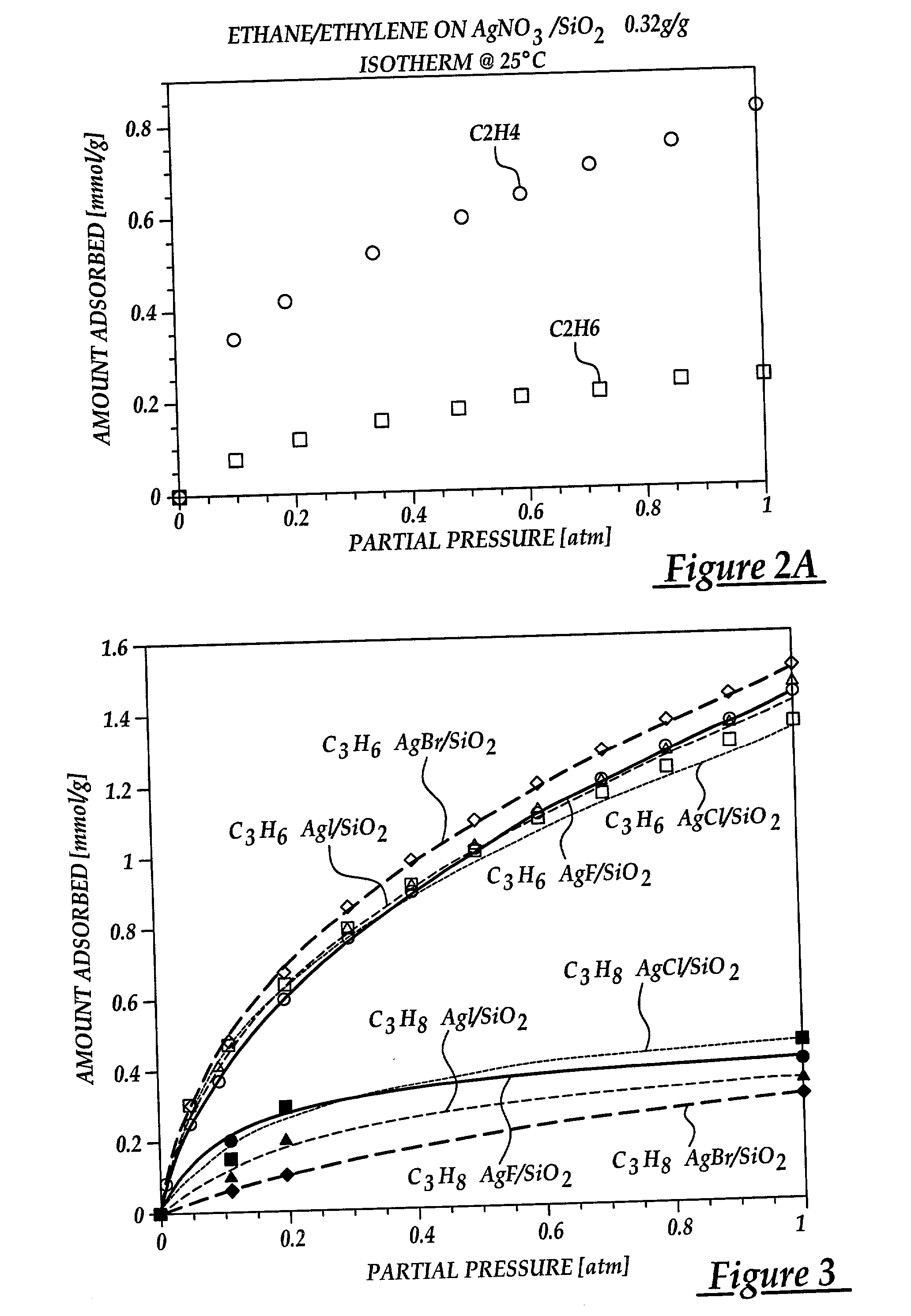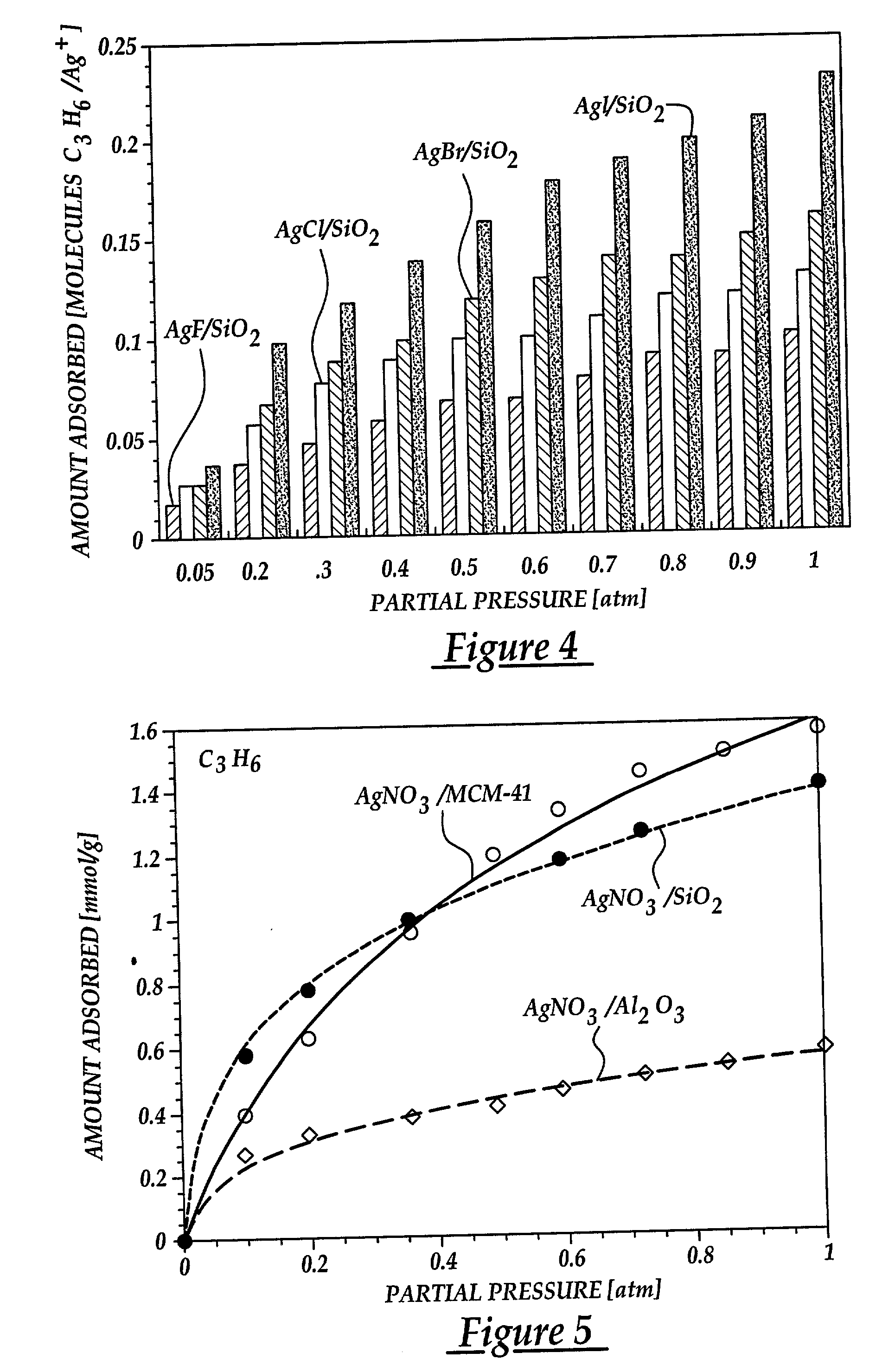Selective adsorption of alkenes using supported metal compounds
a technology of metal compounds and selective adsorption, which is applied in the direction of organic compounds/hydrides/coordination complexes, physical/chemical process catalysts, other chemical processes, etc., can solve the problems of high capital costs and high operational costs of any cryogenic distillation approach, difficult to adapt to commercial use, and high capital costs and operational costs of any cryogenic distillation method. achieve the effect of avoiding the decomposition of metal compounds, effective and economical process and adsorption
- Summary
- Abstract
- Description
- Claims
- Application Information
AI Technical Summary
Benefits of technology
Problems solved by technology
Method used
Image
Examples
example 2
[0071] Anion Effects-Ag-Halide Compounds Supported on SiO.sub.2
[0072] In this example, the effect of various anions on olefin adsorption are shown. By understanding this effect, the adsorptive properties of sorbents are maximized for olefin / paraffin separation. The sorbents were prepared by dispersing silver halides on silica gel via thermal monolayer dispersion. Incipient wetness impregnation was not used due to lack of good solvents. The halides used were AgF, AgCl, AgBr, AgI. The silver halide content of each sorbent was maintained at around 1.0 mmol / g to facilitate comparison. The sorbents were prepared by mixing the metal halide and the silica gel with thorough mixing. The resulting mixture was heated air at 350.degree. C. for 4 days to assure proper spreading. The BET surface areas of the resulting sorbents are shown in Table B.
[0073] Equilibrium isotherms for C.sub.3H.sub.6 at 25.degree. C. on the various AgX / SiO.sub.2 (where X=F, Cl, Br, or I) sorbents are shown in FIG. 3. T...
example 3
[0076] Substrate Effects-AgNO.sub.3 Supported on .lambda.Al.sub.2O.sub.3, SiO.sub.2 and Zeolite
[0077] In order to gain a better understanding of the behavior of .pi.-complexation sorbents, it is necessary to also understand the effects of various substrates on olefin adsorption. This example shows the effect that the chemical and structural properties of the substrate had on adsorption behavior. To this end, several sorbents were prepared by dispersing AgNO.sub.3 over three different high surface area substrates using the incipient wetness impregnation technique described previously. The substrates used were .gamma.-Al.sub.2O.sub.3, SiO.sub.2 and MCM-41 mesoporous zeolite. The MCM-41 utilized is one of a new family of mesoporous silicate molecular sieves with hexagonal arrangement of unidimensional channels with uniform sizes in the range of 20-100 .ANG. (Kresge, et al., 1992; Beck et al., 1992). The MCM-41 utilized had a BET surface area of 1004 m.sup.2 / g and an average pore size m...
example 4
[0086] PSA Cycle Using AgNO.sub.3 / SiO.sub.2 and Comparative Adsorbents
[0087] The effectiveness of these silver salt compounds was further compared to other adsorbents. Three sorbents were used in the following examples; two were commercial sorbents, (4A zeolite and carbon molecular sieve) and one was a .pi.-complexation sorbent of the invention described above (AgNO.sub.3SiO.sub.2). The comparison was based on modelling a PSA cycle, representative of a commercial use of such adsorbents. Equilibrium isotherms, heats of adsorption, and temperature-dependent diffusitives were measured for four gases on three sorbents.
[0088] The 4A-type zeolite used was in powder form. The samples were degassed in vacuo (10-.sup.6 torr) at 350.degree. C. before each experiment. The carbon molecular sieve (CMS) utilized in this work was manufactured by Bergbau-Forschung GmbH in Germany. Unlike Type-4A zeolite, which has a discrete pore size, Bergbau-Forschung CMS has a pore-size distribution between 3 an...
PUM
| Property | Measurement | Unit |
|---|---|---|
| size | aaaaa | aaaaa |
| BET surface area | aaaaa | aaaaa |
| adsorption pressure | aaaaa | aaaaa |
Abstract
Description
Claims
Application Information
 Login to View More
Login to View More - R&D
- Intellectual Property
- Life Sciences
- Materials
- Tech Scout
- Unparalleled Data Quality
- Higher Quality Content
- 60% Fewer Hallucinations
Browse by: Latest US Patents, China's latest patents, Technical Efficacy Thesaurus, Application Domain, Technology Topic, Popular Technical Reports.
© 2025 PatSnap. All rights reserved.Legal|Privacy policy|Modern Slavery Act Transparency Statement|Sitemap|About US| Contact US: help@patsnap.com



